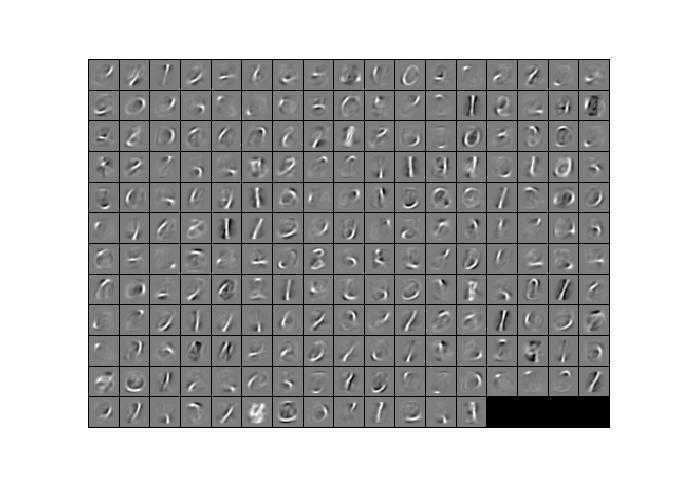标签:
Exercise:Self-Taught Learning
习题链接:Exercise:Self-Taught Learning
stlExercise.m
%% CS294A/CS294W Self-taught Learning Exercise % Instructions % ------------ % % This file contains code that helps you get started on the % self-taught learning. You will need to complete code in feedForwardAutoencoder.m % You will also need to have implemented sparseAutoencoderCost.m and % softmaxCost.m from previous exercises. % %% ====================================================================== % STEP 0: Here we provide the relevant parameters values that will % allow your sparse autoencoder to get good filters; you do not need to % change the parameters below. inputSize = 28 * 28; numLabels = 5; hiddenSize = 200; sparsityParam = 0.1; % desired average activation of the hidden units. % (This was denoted by the Greek alphabet rho, which looks like a lower-case "p", % in the lecture notes). lambda = 3e-3; % weight decay parameter beta = 3; % weight of sparsity penalty term maxIter = 400; %% ====================================================================== % STEP 1: Load data from the MNIST database % % This loads our training and test data from the MNIST database files. % We have sorted the data for you in this so that you will not have to % change it. % Load MNIST database files mnistData = loadMNISTImages(‘mnist/train-images-idx3-ubyte‘); mnistLabels = loadMNISTLabels(‘mnist/train-labels-idx1-ubyte‘); % Set Unlabeled Set (All Images) % Simulate a Labeled and Unlabeled set labeledSet = find(mnistLabels >= 0 & mnistLabels <= 4); unlabeledSet = find(mnistLabels >= 5); numTrain = round(numel(labeledSet)/2); trainSet = labeledSet(1:numTrain); testSet = labeledSet(numTrain+1:end); unlabeledData = mnistData(:, unlabeledSet); trainData = mnistData(:, trainSet); trainLabels = mnistLabels(trainSet)‘ + 1; % Shift Labels to the Range 1-5 testData = mnistData(:, testSet); testLabels = mnistLabels(testSet)‘ + 1; % Shift Labels to the Range 1-5 % Output Some Statistics fprintf(‘# examples in unlabeled set: %d\n‘, size(unlabeledData, 2)); fprintf(‘# examples in supervised training set: %d\n\n‘, size(trainData, 2)); fprintf(‘# examples in supervised testing set: %d\n\n‘, size(testData, 2)); %% ====================================================================== % STEP 2: Train the sparse autoencoder % This trains the sparse autoencoder on the unlabeled training % images. % Randomly initialize the parameters theta = initializeParameters(hiddenSize, inputSize); %% ----------------- YOUR CODE HERE ---------------------- % Find opttheta by running the sparse autoencoder on % unlabeledTrainingImages opttheta = theta; % Use minFunc to minimize the function addpath minFunc/ options.Method = ‘lbfgs‘; % Here, we use L-BFGS to optimize our cost % function. Generally, for minFunc to work, you % need a function pointer with two outputs: the % function value and the gradient. In our problem, % sparseAutoencoderCost.m satisfies this. options.maxIter = maxIter;% Maximum number of iterations of L-BFGS to run options.display = ‘on‘; [opttheta, cost] = minFunc( @(p) sparseAutoencoderCost(p, ... inputSize, hiddenSize, ... lambda, sparsityParam, ... beta, trainData), ... opttheta, options); %% ----------------------------------------------------- % Visualize weights W1 = reshape(opttheta(1:hiddenSize * inputSize), hiddenSize, inputSize); display_network(W1‘); %%====================================================================== %% STEP 3: Extract Features from the Supervised Dataset % % You need to complete the code in feedForwardAutoencoder.m so that the % following command will extract features from the data. trainFeatures = feedForwardAutoencoder(opttheta, hiddenSize, inputSize, ... trainData); testFeatures = feedForwardAutoencoder(opttheta, hiddenSize, inputSize, ... testData); %%====================================================================== %% STEP 4: Train the softmax classifier softmaxModel = struct; %% ----------------- YOUR CODE HERE ---------------------- % Use softmaxTrain.m from the previous exercise to train a multi-class % classifier. % Use lambda = 1e-4 for the weight regularization for softmax % You need to compute softmaxModel using softmaxTrain on trainFeatures and % trainLabels lambda = 1e-4; options2.maxIter = maxIter; softmaxModel = softmaxTrain(hiddenSize, numLabels, lambda, ... trainFeatures, trainLabels, options2); %% ----------------------------------------------------- %%====================================================================== %% STEP 5: Testing %% ----------------- YOUR CODE HERE ---------------------- % Compute Predictions on the test set (testFeatures) using softmaxPredict % and softmaxModel [pred] = softmaxPredict(softmaxModel, testFeatures); %% ----------------------------------------------------- % Classification Score fprintf(‘Test Accuracy: %f%%\n‘, 100*mean(pred(:) == testLabels(:))); % (note that we shift the labels by 1, so that digit 0 now corresponds to % label 1) % % Accuracy is the proportion of correctly classified images % The results for our implementation was: % % Accuracy: 98.3% % %

feedForwardAutoencoder.m
function [activation] = feedForwardAutoencoder(theta, hiddenSize, visibleSize, data) % theta: trained weights from the autoencoder % visibleSize: the number of input units (probably 64) % hiddenSize: the number of hidden units (probably 25) % data: Our matrix containing the training data as columns. So, data(:,i) is the i-th training example. % We first convert theta to the (W1, W2, b1, b2) matrix/vector format, so that this % follows the notation convention of the lecture notes. W1 = reshape(theta(1:hiddenSize*visibleSize), hiddenSize, visibleSize); b1 = theta(2*hiddenSize*visibleSize+1:2*hiddenSize*visibleSize+hiddenSize); %% ---------- YOUR CODE HERE -------------------------------------- % Instructions: Compute the activation of the hidden layer for the Sparse Autoencoder. activation = sigmoid(W1 * data + repmat(b1,1,size(data,2))); %------------------------------------------------------------------- end %------------------------------------------------------------------- % Here‘s an implementation of the sigmoid function, which you may find useful % in your computation of the costs and the gradients. This inputs a (row or % column) vector (say (z1, z2, z3)) and returns (f(z1), f(z2), f(z3)). function sigm = sigmoid(x) sigm = 1 ./ (1 + exp(-x)); end
【DeepLearning】Exercise:Self-Taught Learning
标签:
原文地址:http://www.cnblogs.com/ganganloveu/p/4214639.html